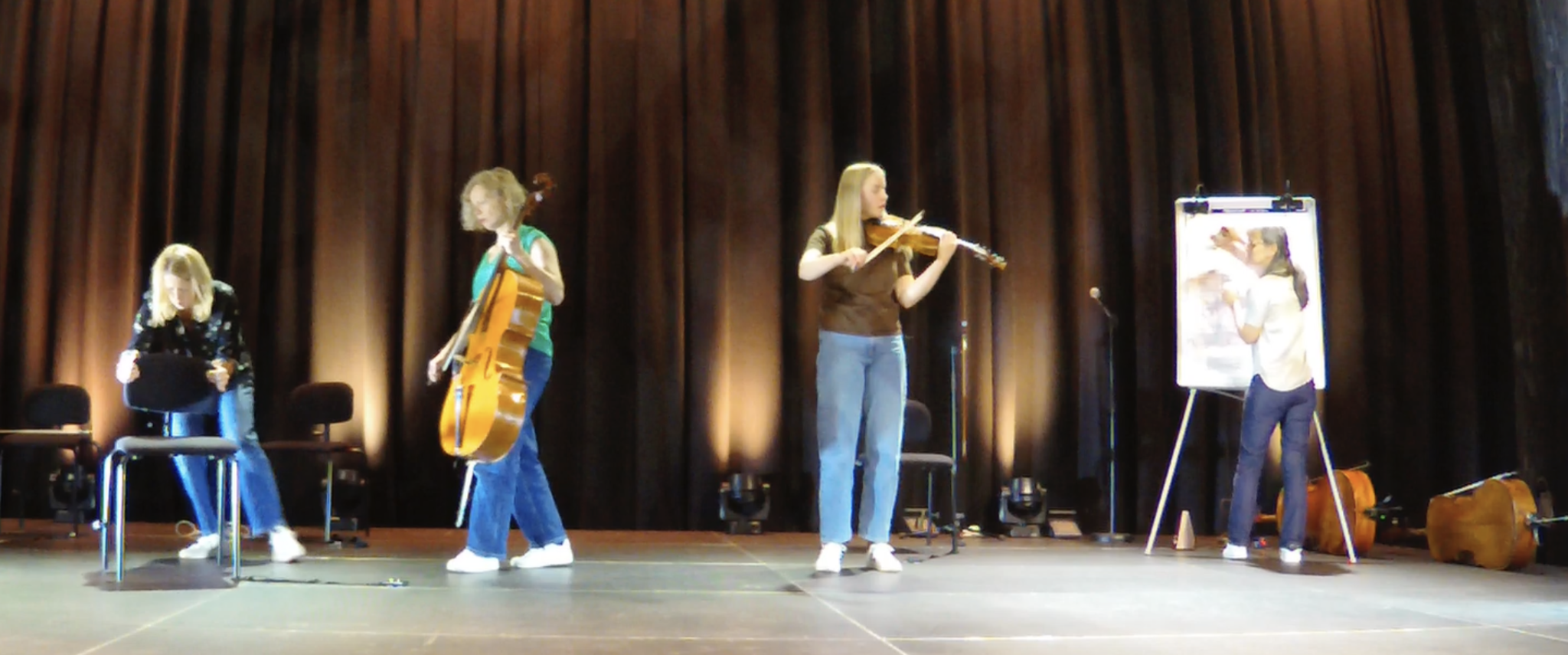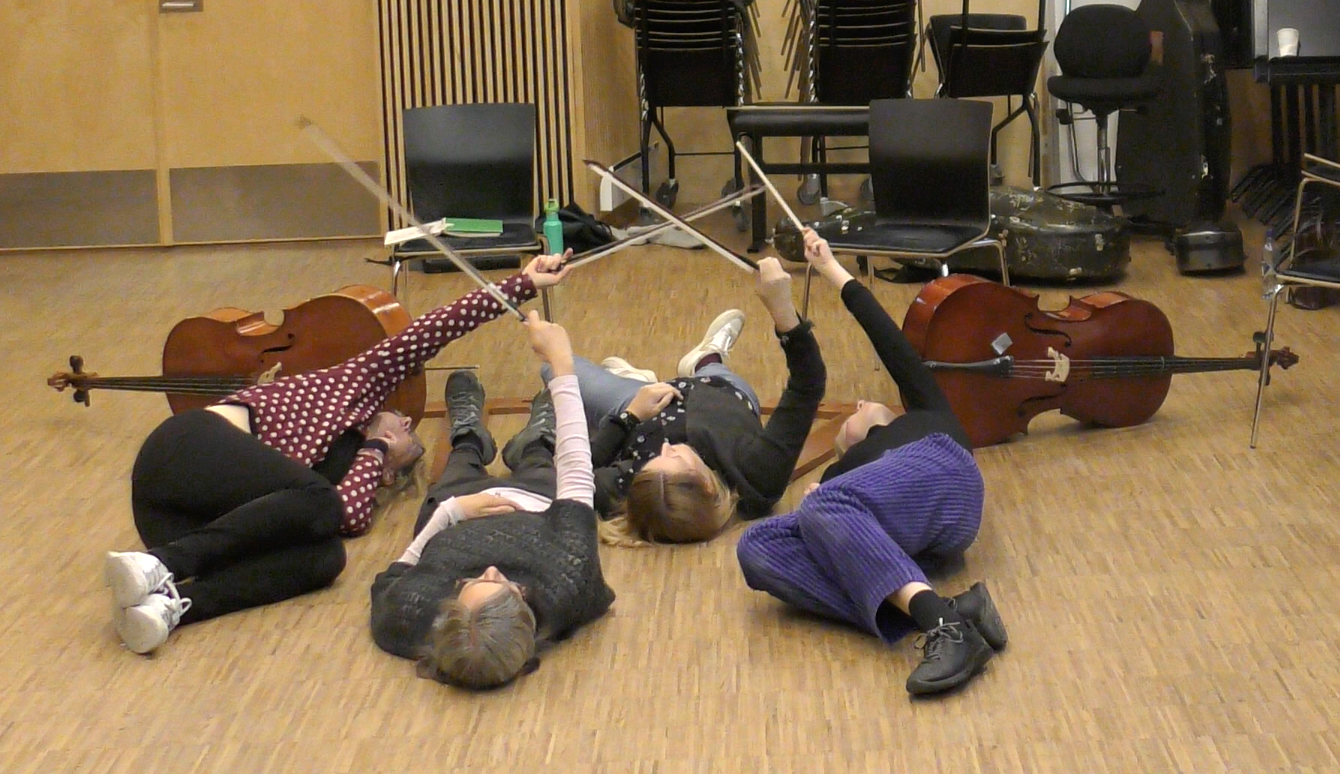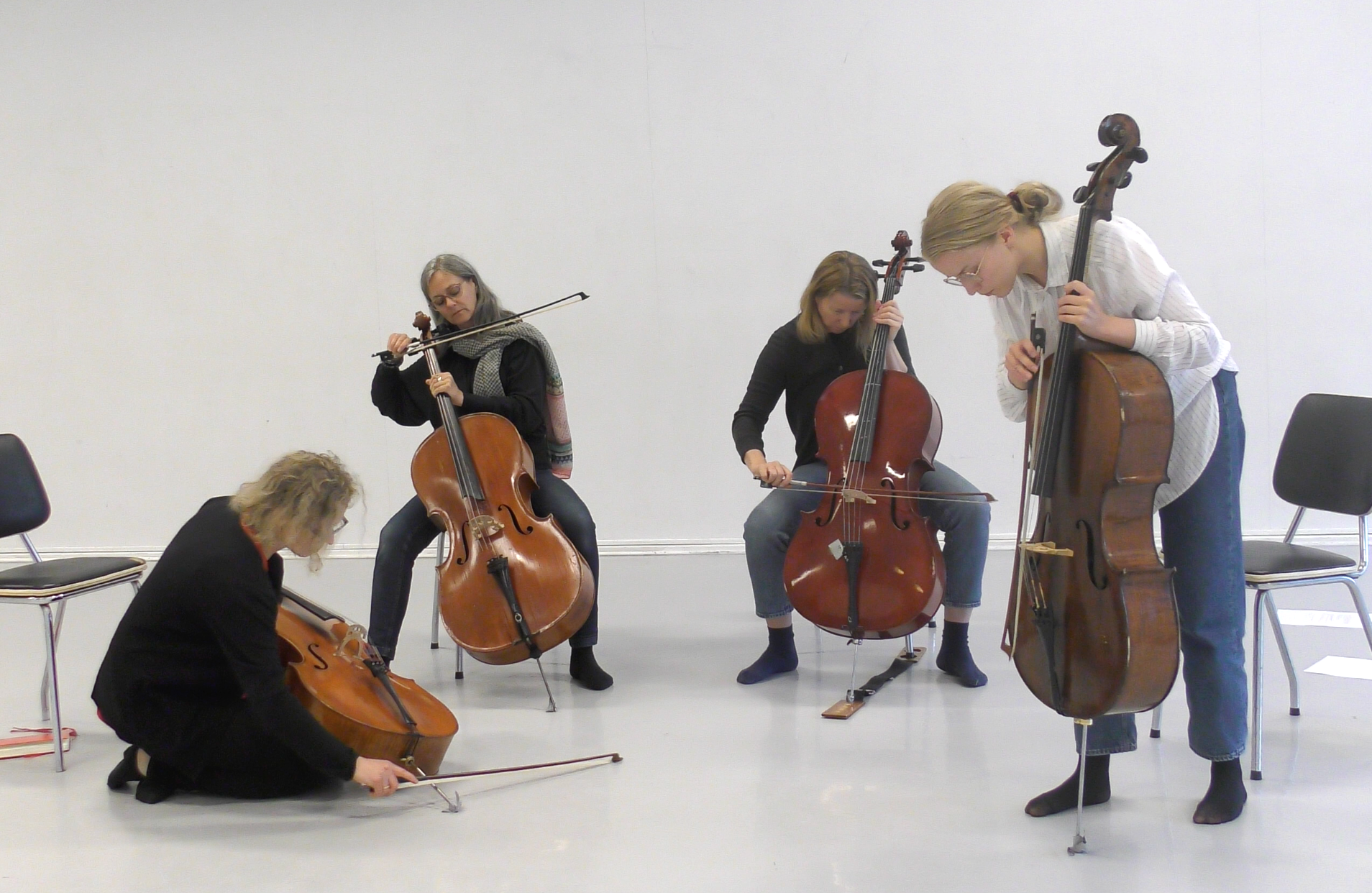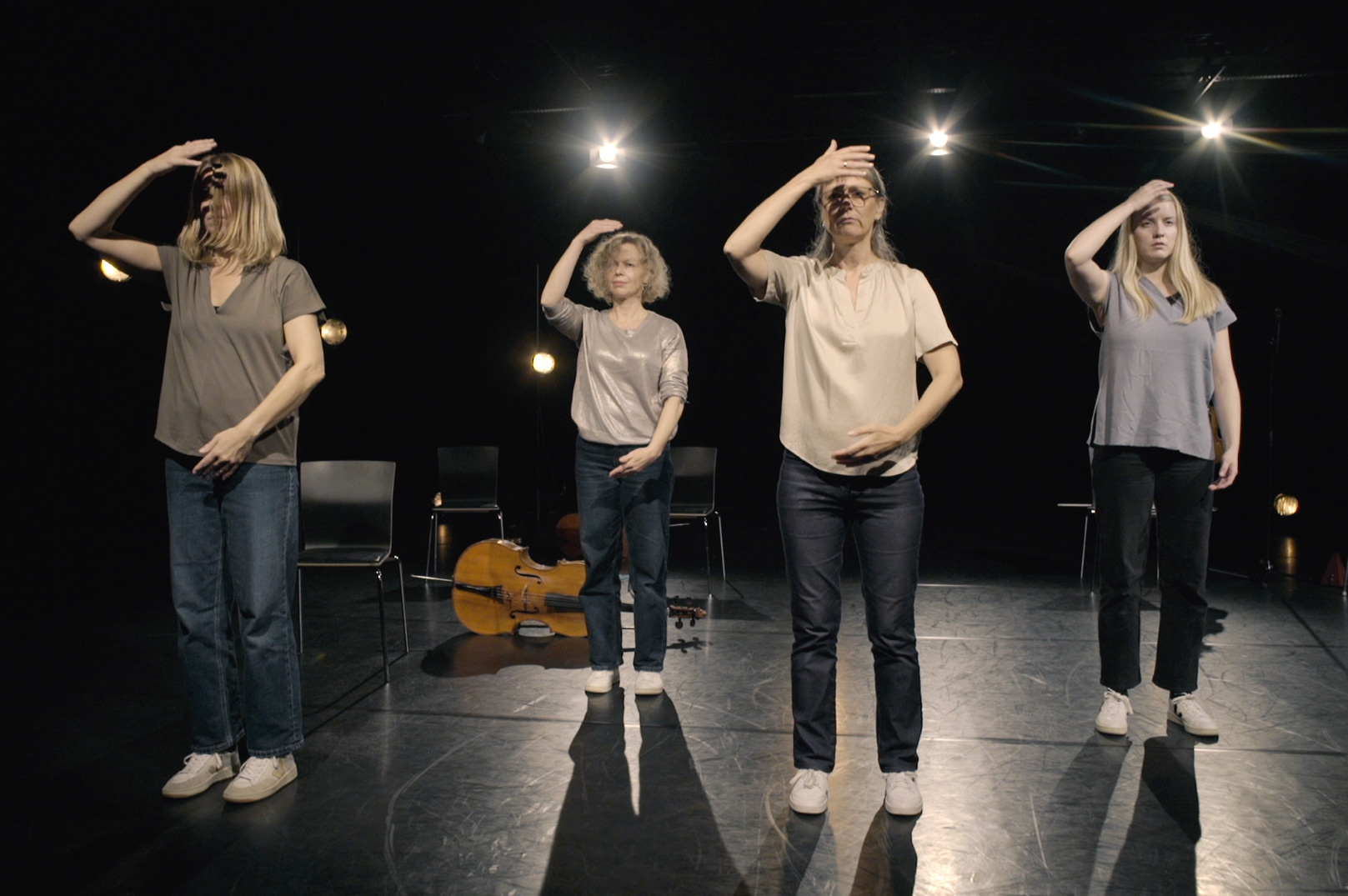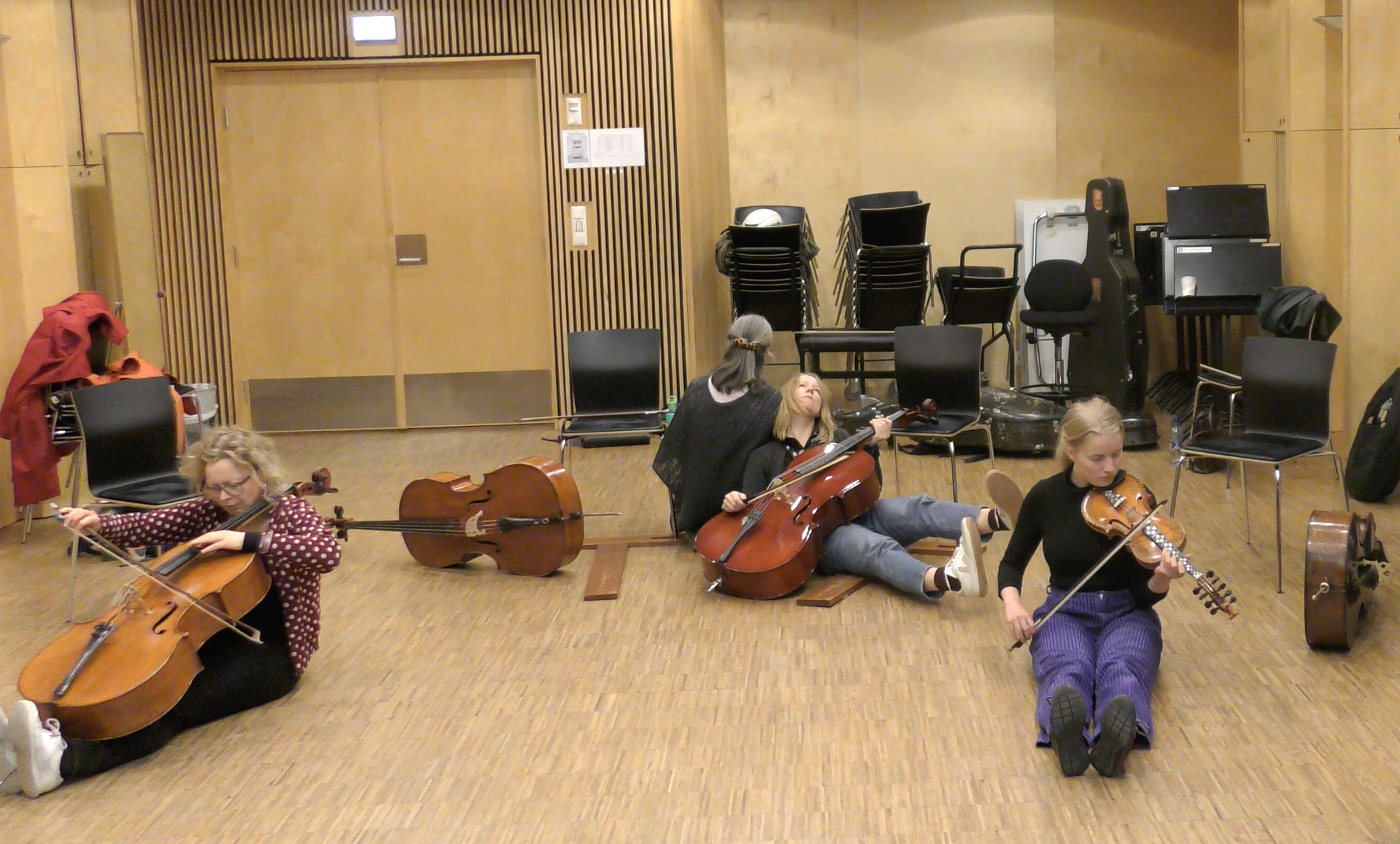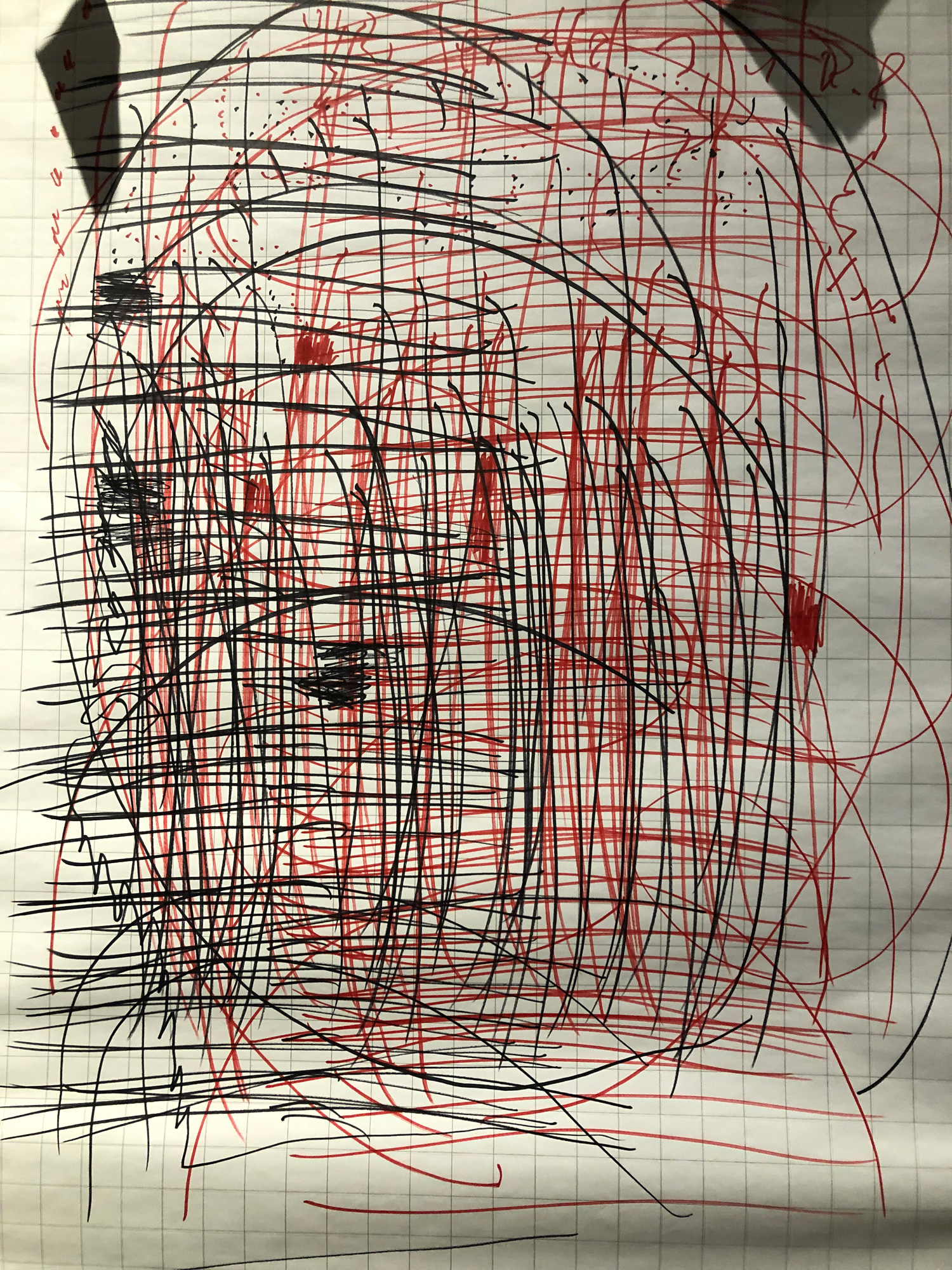The project · Ensemble Studies · BLY · The Hands. The Double. · Seminars
•
Artistic work · Creation and collaboration · Becoming an Ensemble
Ensemble Studies started from the idea of working with the common stories and experiences that lie inherent in the bodies of performers in an established music ensemble. When for several reasons this was not possible to implement, the composer, Tanja Orning, was forced to rethink her concept. I was engaged as a dramaturg in the research project Extended Composition, of which Tanja’s project formed a part, and I suggested that Tanja extend her thinking of ensemble and reach for collaborators outside the core project group. Through our conversations, I ended up as a performing dramaturg in the piece, together with Tanja, as the performing composer, dancer Gry Kipperberg, and folk musician and singer Helga Myhr, who were invited to take part. This forced us to think differently about the notion of ensemble, and we explored how an ensemble is formed and how to compose as an ensemble.
Time is a central factor for an ensemble. A dialogue must be established in which sensitivity, listening to each other and trust are central. Over time a common practice and vocabulary are developed. One advantage of a funded research project is the different time frame offered, compared to what is given in the professional reality of performing artists and musicians. The time frame we had – we worked together over the span of a year and a half – was expansive enough to facilitate a process of searching, getting lost, and finding a way creating different pathways.
Through our process, Donna Haraway’s concept of ‘tentacular thinking’ (Haraway 2016), and concretely the octopus, became an image we could work with. Ensemble work is not only about finding a common voice or sound. An ensemble can both explode and implode in many different directions, while being held together by a common head and body. The octopus is regarded to be a very intelligent animal. It might look like the various arms are moving randomly in all directions, but the octopus always has control of its tentacles. She feels her way through unknown terrain as a way of gaining new knowledge. To extend is to find one’s way.
The word tentacle stems from the Latin word tentaculum, and means to try, but also to feel. The ensemble tries to find a common form, even if sometimes it reaches out in different directions. Each performer is like a tentacle that locates itself in interaction with the others through feeling its surroundings. Haraway introduces the concept ‘tentacular thinking’ as a way of pointing to a world that must be experienced through the senses, and through feeling one’s way and testing things out. The ensemble explores how we experience the world if we extend the sensuous experience through several eyes, arms and legs.
An octopus is a mollusc without a skeleton. That makes its movements more floating and less strict in its form. To a large extent it adapts to its terrain, which is in constant transformation and change. This has also characterized the work with Ensemble Studies. Together we have found an interdisciplinary dialogue and developed knowledge about each other as artists and co-players. At the same time this is a new collaboration that does not have the kind of core understanding one might find in an established ensemble that has been working together over several years. The intuitive understanding and knowledge of the others’ musical habits is lacking, and this has made the metaphor of the octopus’ tentacles and its formlessness especially rich for us.
INTERDISCIPLINARY COLLABORATION
Coming together from different artistic practices (music, dance, theatre) does take time. For us it became as sort of interdisciplinary groping in which it was unclear what we were searching for. A musical ensemble consists of relations between performers, instruments and the material that is developed through and in this relation. In an interdisciplinary collaboration like this, it is difficult for the individual performer to operate from a known set of repertoire, style or approach. It is thus not an encounter between established practices, because we had to move outside our own artistic context and genre. Each one of us naturally brought with us our expertise from various fields, but the work and explorations challenged these, because they also depend to a certain extent on established professional communities.
We had a long series of improvisational sessions, simply sharing space and time with what we knew how to do: playing cello or Hardanger fiddle, moving, or speaking words and finding actions. Through sharing space and time and listening to each other, trying to respond to what takes place in that space, we also affected each other. Because our points of departure were different, this took surprising forms. Traces of this exploration are found in the final performance. An example of this is some of the words that showed up in an early improvisation (inside/outside), which I said sitting on a chair partly turned away from the other three working on the floor with instruments and movement. Another trace is the exploration of movement as sound (see in the film below where we explore movement with the cello bow), where the visual movement of playing the cello without producing sound remains in the performance. Much of what came out of these sessions was uninteresting artistically, but it was still important in cultivating the ensemble, spending time together and producing stuff to build further on. We also wanted to introduce each other to our different disciplines. We all moved our bodies, we all improvised with text, and we were all introduced to the cello and bow. Thus, we all moved between mastering and virtuosity, and embracing being an amateur.
This exploratory and groping work is a negotiation between knowledge understood as virtuosity – that is the competence of treating one’s instrument or material – and amateurism where one is thrown into uncharted waters, trying things out as a beginner. This negotiation takes place in a professional research context and thus demands that the performers are able to stand in the tension between the known and the unknown. It is in such a groping landscape that something new can grow, nourished by the relationships that are established and developed over time. The somewhat clumsy fumbling opens room for the amateur, it opens a space for the imperfect and question notions of quality in the tension between being virtuosic and professional in one area and amateur in another. Both entrance points exist simultaneously in the rehearsal space. In this case the dancer and dramaturg are experienced in composing with movement and words in space, but inexperienced with playing a cello and Hardanger fiddle in a musical composition. The two musicians are virtuosic with their instruments, musical improvisation – and composition, but they are insecure when it comes to movement as an expression of its own, where the body is in focus. All four are experienced in ensemble work, listening, improvising and collaborating.
The challenge of playing a cello in front of an audience, not ever having played this instrument before, demanded a playful attitude where I had to trust composer and cellist Tanja Orning completely. The work was to learn precisely what was needed to serve the overall composition. For me, playing cello in this piece meant engaging in dialogue with the instrument – a stranger. It was an exploration of sounds the instrument and I could produce together, grounded in my competence and experience of scenic presence, movement and object-theatre. Josh Spear has referred to the way Barbara Bolt uses Judith Butler to argue that it is through repetitive practising that artists come into being as artists. This excludes in many ways the form and expression of the amateur, which may have an effect in a virtuoso performance. The research funds we received allowed me the time to rehearse what I was supposed to play with the cello. However, it was naturally nowhere near the time I would have needed to even get close to any virtuosic playing. Amateurism is an aesthetic form which has been refined by performance groups like Baktruppen and Forced Entertainment. The performers in these companies have after many years become virtuosic in the aesthetic of amateurism. As Bolt points out, the expression of the amateur is also the source of innovation and movement.
Interdisciplinary collaboration in this case implies a nearing between us, through sound and movement. We are like ‘blobs’ with different disciplinary viewpoints and competences that we carry with us into the shared space. Maurice Bloch uses the concept of the ‘blob’ to articulate the way we affect each other in social contexts. We move in and out of each other’s bodies as well as each other’s minds (Bloch 2012, p. 139). Blobs can collide, gather and melt, but they cannot melt together and become one. The tentacle touches, like my body touches the cello. Through this sensuous touch they both morph and transform to a certain degree. However, the physical contact also speaks of difference, of the needed courage and effort of such a meeting. The extensions and stretching that is demanded to learn.
TEXT MATERIAL
As a dramaturg and theatre practitioner I wanted to work text into our composition. I have been interested in exploring text on stage, not as something connected to the inner life or psychological movements of a subject or a character, but rather as a material equal to sound, objects, light, movement and bodies in the performance space. This is a dramaturgical form, which Hans-Thies Lehman (2006) has coined postdramatic theatre, indicating that text in theatre has recently acquired a different role than it previously held in the literary theatre tradition. Since the emergence of the avant-garde movements in the arts from the 1950s, and the influence on theatre from performance art, experimental music and dance, text is merely one of many means of action. Text is increasingly incorporated into the mix of musical material in the emerging field of extended composition that Jennifer Walshe calls The New Discipline (Walshe 2016). As we have experienced in this research project, this is often problematic because words are so concretely descriptive and take over the space of interpretation as soon as they appear. So how can words and text be integrated in the composition without taking the focus as soon as they are uttered? I believe it is both a matter of where the text is placed in the overall soundscape, but also of the way the text is delivered on stage. We tried many ways of incorporating text: speaking coherent text turns the music into a backdrop to the meaning so quickly captured from logical sentences. Whispering text seeps through the soundscape and lays like a blanket over the whole composition, giving it an interpretative frame. I needed to play with words without an intention and without looking for understanding.
An actor or performer can work with text without working on analysis and interpretation by focussing on tempo, pitch and volume with the goal of creating a distance, or a gap, between the performing body and the sound of the words. Sending the sound out into the space is a sharing with an audience, which allows for a listening and interpreting situation in the moment of performing. It implies a process of (re)discovering the words together with the audience, trying to avoid loading them with subjective meaning, letting the text carry its own agency influencing the space and the bodies present. In the process of developing text for Ensemble Studies, we tried different exercises. One, which is known especially from the theatre companies Wooster Group and Nature Theater of Oklahoma, but is used by many companies working with documentary and verbatim methods, is to have a text/voice in the ear played from an external device such as a mobile phone. The performer should not know the text too well and should speak what they hear. Another exercise is to have one performer stand behind another and whisper a text, which the other performer then speaks out loud. Both methods are ways to explore the sound of a text through working physically with vocal cords and articulation. It leaves little time for interpretation, which instead floats more freely, affected by the moment of performing. It contains a transmission and discovery of the text in the same moment, simultaneously demanding a profound listening practice. This is not an easy task, as is demonstrated in the following video clip from rehearsal. In this example we were testing out a text expressing colonial and racist structures to bring in a topic that felt potent and relevant. As is shown we also tried a more poetic text about nature and weather.
These practices were ways for the ensemble to dare experimenting with text in new ways, and for performers less accustomed to performing text to get comfortable with speaking in front of an audience, without having to learn methods and techniques from acting practices. The point with this kind of text work is the immediate reaction in the performer, the effort and labour of listening and speaking simultaneously, which again hinders an interpretation of the words. However, these masses of text still brought a topic or a theme into the compositional frame, which we did not look for. We needed to cut up the words, split them and create distance between them to hear them anew.
Eventually specific texts tend to find their own way into the work. As mentioned above, some words from one of the very early improvisations (see the video ‘Interdisciplinary fumbling’) words of inside/outside, in/out emerged and stayed with us throughout the work. It was difficult to figure out how the text should be spoken and from where in the room. It matters whether a text is delivered from the front of the stage or the back, standing or seated. To get the words more integrated as a part of the musical composition, Tanja suggested I make a rap-like sequence. I have never created a rap before, and I am not sure I succeeded this time. However, the ‘rap’ we ended up using was fun and offered me a new experience in working with words with a musical approach. In rap the words have a percussive function, they are an instrument. With the idea of a ‘rap’ I could explore the rhythm of words and focus on the musical rhythm in a series of words instead of worrying about whether they made any sense. In this way words more easily integrate into the overall musical composition, fluctuating between audibility and dissolving into the other sounds in the space. For the audience this demands an acceptance of not always hearing the words, a letting go of understanding, and a diving into a complex sound scape. It is undeniable, however, that words carry meaning and quickly frame the other sounds; and so it was in this case. There is much more potential to explore letting the words dissolve into the soundscape as such through chopping up words, balancing between meaning and non-meaning.
PERFORMING DRAMATURGY
It is unclear whether Ensemble Studies should be framed as a concert or a performance piece. Perhaps it does not matter, and perhaps it can be framed according to the context in which it is performed. Josh Spear points to the importance of the framing as an indicator for audiences on how to hear, see or interpret a work (Spear 2022). Spear develops this into a ‘framing method’ used in devising processes, and Tanja Orning points to this in her text. When theatre was influenced by performance art, beginning in the 1960s, the concept of ‘performance – theatre’ emerged. I don’t know whether ‘performance art – music’ is a term, but it seems to me that much of what is referred to as The New Discipline (Walshe 2016) in the music field is influenced by performance art perhaps more than theatre and dance as disciplines. I claim this because contemporary music is far from working with illusion, fiction or make believe which is one of the traditional traits of theatre and ballet.
Performance art makes a claim to authenticity, meaning that it is neither fiction nor abstraction but focuses on the physicality of the staged activity. The influence of performance on theatre and dance from the 1970s (alongside the developments of ‘deconstruction’ and ‘post-modern’ as central philosophical terms) urged forth the concepts of ‘real-time’ and ‘real-space’ as opposed to fictional time and space. This is what characterizes The New Discipline as well. When it comes to modes of performing, it also corresponds better to the performance art tradition than to acting or even dance methodologies. This does not mean however, that musicians and composers cannot benefit and learn from some of these performing methods, but they need to be merged with and adjusted to the reality of music performance. Musicians are accustomed to performing the activity of playing their instrument with a concentrated focus on sound. All attention needs to be given to listening and to the relationship between performing body and instrument. This relationship changes with The New Discipline, where the body and identity of the performer become part of the situation to a greater extent. In performance art it is the activity, the doing of text, sound, movement that matters – it is what we call ‘action based’. Interpretation becomes something that happens in the moment, in relation to whatever plays into the situation, and depends rather on a sense of rhythm and composition. Marvin Carlson writes about performance: ‘Since the emphasis is upon the performance and on how the body or self is articulated through performance, the individual body remains at the center of such presentations’ (Carlson 2016, p. 75). The question is then how one can work with the body as another instrument into the composition. On this matter, there is a lot to learn from contemporary dance, which is also action-based in real time and real space.
In my work I understand dramaturgy as a form of compositional practice, which in a post-dramatic paradigm, deals with the entire space as a compositional frame: sounds, words, space, movement, light, visuals etc. I depart from a position of listening and looking at what takes place in the rehearsal space. This triggers sensorial and bodily reactions, which set in motion physical energetic rhythms that create images, connections, thoughts and ideas. Theatre pedagogue Jacques Lecoq, with whom I have studied, said:
The dynamics underlying my teaching are those of the relationship between rhythm, space, and force. These laws of movement have to be understood on the basis of the human body in motion: balance, imbalance, opposition, alternation, compensation, action and reaction. These laws may all be discovered on the body of a spectator as well as in that of an actor. (Lecoq, 2002, p. 21)
In Ensemble Studies we obviously worked on sound: the relationship between the sounds of the cello, the Hardanger fiddle, the sound of jumping feet on the ground, words or the sound of the amplified markers on the sheet of paper. There are different rhythmical patterns that intertwine between those sounds. However, we also worked on the movements between us, and on how the movements rhythmically activated the room. Movements have rhythm, even when they don’t make sound, and it is a rhythm that can be perceived visually and kinaesthetically. An example is the section where the cello and Hardanger fiddle player are in the front of the stage, while the dancer and dramaturg are moving legs and arms seated at the back. There is a tension and opposition in the space between those four bodies, created also because of the distance and placement of them in the space. The movers work on balance and imbalance, and the musicians on action and reaction.
There are also other examples where we work on action and reaction between sound from the Hardanger fiddle and the dancer’s movements, or between sound from the cello and the drawings on paper. The final image with movement in silence also work with tension between performers and audiences, a slow rhythm, insisting on moving in silent, rhythmically sounding the space, where audiences are invited to listen with their eyes rather than their ears.
I further believe dramaturgical work to be a shared practice. Everyone involved is part of shaping the work. Everyone takes part in the dramaturgical and compositional labour. This challenges authorship and positions of power – director, choreographer, composer or dramaturg – in collaborative work. Tanja was clearly the composer of this piece, which means she spent time between rehearsals thinking about the overall compositional structure and develop ideas for things to do the next time we met. However, in the moments of rehearsal she was a performer on equal level with the Hardanger fiddle player, the dancer and the performing dramaturg. It meant a level of humility, listening and interest in the others’ ideas, further challenging ego positions, and letting go of a certain level of control and sometimes artistic visions.
Combining the roles of composer and musician or dramaturg and performer in a single production is a challenging task. It involves both leaning into the material and leaning out of it to get the overall view. The process of developing Ensemble Studies can be called a ‘devising process’. In their book Dramaturgy and Performance, Cathy Turner and Synne Behrndt write about the role of the dramaturg in devising processes. Devising, they say, is a method of developing material, be it a play, a performance score or perhaps a music score, which does not exist prior to the process of collective creation. The score is developed through this process, growing out of improvisations and collaborative development of the material. It is ‘a search for structure, while on the other hand, the facilitation of possibilities’ (Behrndt & Turner, 2008, p. 171). They argue that it is perhaps precisely because of this sometimes-chaotic process that an overview and structural organization is needed. In the case of Ensemble Studies Tanja and I had to go in and out of losing ourselves in the improvisational practices in rehearsal and stepping back developing structures and coherence.
If the dramaturgical work is shared, what then could I offer as a performing dramaturg? I believe everybody involved in a devising process offers something through their presence in the room, related to their different orientations in the world and what their practices are. The daily practice of the dancer is usually based on body alignment, movement and refinement of choreographic material. The musicians practice their instrument through precision and refinement, and the dramaturg spends much time looking, discussing and reading the contemporary context in which the work will be perceived. Our different disciplinary competences are what each of us see/hear first in the compositional work. Through the process we negotiate between those positions. Because the context for Ensemble Studies is musical composition, sound is the primary guiding principle. However, at certain moments, as seen in the section called ‘head banging’ where all four performers play noise sound on the cellos while moving the head and hair, the visual image and movement is equally important. At the end, where all four performers have left their instruments behind, it is movement that is the guiding principle, and in moments during the ‘rap’ the words are in the foreground.
SMOOTH SPACES
As a dramaturg I am concerned with the societal and political context in which a work is produced and read. My interest in how the artwork speaks with and to other professional fields takes me into thinking further with the work we produced in the context of the research project Extended Composition. In the following I explore ideas about the relationship between virtuoso and amateur positions, and how this relates to notions of professionalism and training. How can we extend our practice and knowledge? What is the self-awareness of the professional artist, and how does she relate to the institutional networks she is part of, and how does this affect interdisciplinary collaborations and innovation? How can we practice interdisciplinary collaborations with the Deleuzian understanding of ‘creating in a state of becoming’? To do so we need to have a disciplinary platform, but also to learn and transform into unknown formations through encounters with others. Thinking with Deleuze and Guattari’s concept of ‘smooth and striated spaces’, may be a tool that can inspire methods for this kind of work. Among other things they refer to ‘the musical model’ and Pierre Boulez to discuss these concepts. The striated space is an ordered one, which offers structure, while the smooth space entangles and moves in haptic modes in and around those structures.
The striated is that which […] produces an order and succession of distinct forms, and organizes horizontal melodic lines and vertical harmonic planes. The smooth is the continuous variation, continuous development of form. (Deleuze & Guattari 1987, 478)
The relationship between the specialized and non-specialized performer may be seen as the striated, trained performer encountering the smooth non-trained performer in a tentacular way. In this relationship the trained performer is not only demonstrating and perfecting skills but is also moving into unknown territories in a state of becoming – always an amateur in becoming virtuosic. Inspired by Gilles Deleuze, Lotta Johansson frames this as a ‘pedagogy of becoming’ (2019). Johansson’s project is to address teaching and learning situations in the elementary school system. But I believe it is also applicable to disciplinary training and frameworks found in arts educations that influence creative working hierarchies and roles in professional contexts. To extend one’s practice is to move into unknown territory where we become amateurs. Referring to Deleuze, Johansson writes that only when moving on the border between the known and the unknown we will be able to create something new: ‘It is about staying in the liminal space, between knowledges that are and knowledges that could be, between knowing and not-knowing and between understanding and not-understanding’ (Johansson, 2019, p. 52, all translations of Johansson are my own). In a sense we all know this to be central for artistic work, but it is more rarely considered when it concerns artistic subjectivity and roles in collaborative work. In this regard the stable subject is often still thriving. The identity of being a composer or a dramaturg, our specific skills, power of definition, interest and opinions are often insisted upon. Our institutional structures support this and it becomes difficult to navigate otherwise. In a project inspired by Deleuzian thinking, the question is not what a person (composer, dramaturg, performer, musician) is, but what she can temporarily become.
Working from a point of forming a new ensemble, where we improvise through a process of getting to know each other professionally and personally, moving into unknown spaces of non-specialized skills, without a clear vision of where we are going – we start with an empty space and an empty sheet. Johansson takes Deleuze and Guattari’s notion of the smooth space as a starting point, as a space that is not already occupied with conventions, expectations and prefabricated knowledge and specializations. ‘The smooth spaces are open and unidentified, which implies that they open up for movement’ (Johansson, 2019, p. 122). These spaces are realizable when we challenge and question established knowledge and stable identities. It allows for movements, unpredictable alignments and assemblages that offer potentials for transformation. It is a challenging task to create such spaces, however, concretely and in our mode of collaborating. Using the idea of a smooth space as a conceptual frame for working together, we are moved into unknown territories.
Through the movements that float in spaces that are smooth, the subject’s borders are challenged, they loosen up – in the interconnection with something else, with other components that in their composition differ from the subject in the given moment. (Johansson, 2019, p. 123)
Johansson points out that smooth spaces are found only in moments. Being in such moments is perhaps what can be described as a feeling of flow. The smooth space must be established again and again. It is quickly occupied by habits, conventions, structural demands, time restrictions and perhaps even skills. It is in the tension between smooth and occupied spaces that productivity and creativity emerge.
When performing in Ensemble Studies, I had not been on stage for many years. After having moved from being a performer in the 1990s, I have developed my work as a dramaturg since 2001. I was invited into the research project Extended Composition to serve as a dramaturg for all composers involved. To begin with I gave a few workshops and improvisational tools to everyone involved in the research project. These offered ways to deal with text in a spatial composition. Through various circumstances and developments in Extended Composition, I ended up focusing on the collaboration with Tanja Orning and her piece.
I came to the work with certain skills and interests connected to the use of text in performance composition. It was difficult to find a place for words in the fumbling of the beginning of the ‘tentacular’ ensemble work. Working with an instrument – the cello – was like learning to swim in deep waters where your arms and legs move in panic to keep your head over water. However, when I began to trust the competence of Tanja and Helga, I could start to relax, float, relate and listen in my own way with the instrument. This listening involved not only sound, but how it felt to move with the cello and how the form and texture of the wood felt against my skin. What could this body and my human body do together? I think the trust, listening and floating was a way to smooth out the creative space that the four of us shared – even if only in moments. We were all exploring unknown places where we were amateurs, using our skills like tentacles to find new territories, places we had never been before. As a dramaturg, often using writing as a tool in various ways, in this collaboration I could miss not having an instrument. Even the dancer has her instrument, which is her own body. I found great pleasure in developing the amplified markers on paper as ‘my’ instrument. Then I could work on writing and drawing as movement and rhythm, generating sound. Each performance starts with an empty sheet. Slowly in collaboration with the other performers in the ensemble, movements and rhythms are added, through listening, playing with and adding to the composition. Each performance produced a visual trace, a space to dive into for further possible explorations.
References
Behrndt, S. and C. Turner (2008) Dramaturgy and Performance. Basingstoke: Palgrave Macmillan.
Bloch, M. (2012) Anthropology and the Cognitive Challenge, Cambridge: Cambridge University Press
Carlson, M. (2016) 1What is performance?1 in H. Bial, and S. Brady, eds., The Performance Studies Reader, 3rd edn. London: Routledge
Deleuze, G. and F. Guattari (1987) A Thousand Plateaus. London: Continuum.
Haraway, D. (2016) Staying with the Trouble. Durham, NC: Duke University Press.
Johansson, L. (2019) Blivandets pedagogik, utbildning för en annan tid. Lund: Studentlitteratur.
Lecoq, J. (2002) The Moving Body: Teaching Creative Theatre. London: Methuen.
Lehman, H.-T. (2006) Postdramatic Theatre. London: Routledge.
Nancy, J.-L. (2007) Listening. New York: Fordham University Press
Spear, J. (2022) ‘The New Discipline’, in Composing Together and Not Together. PhD Critical Reflection, Norwegian Academy of Music. www.researchcatalogue.net/view/1377266/1386400.
Walsh, J. (2016) http://milker.org/the-new-discipline/
